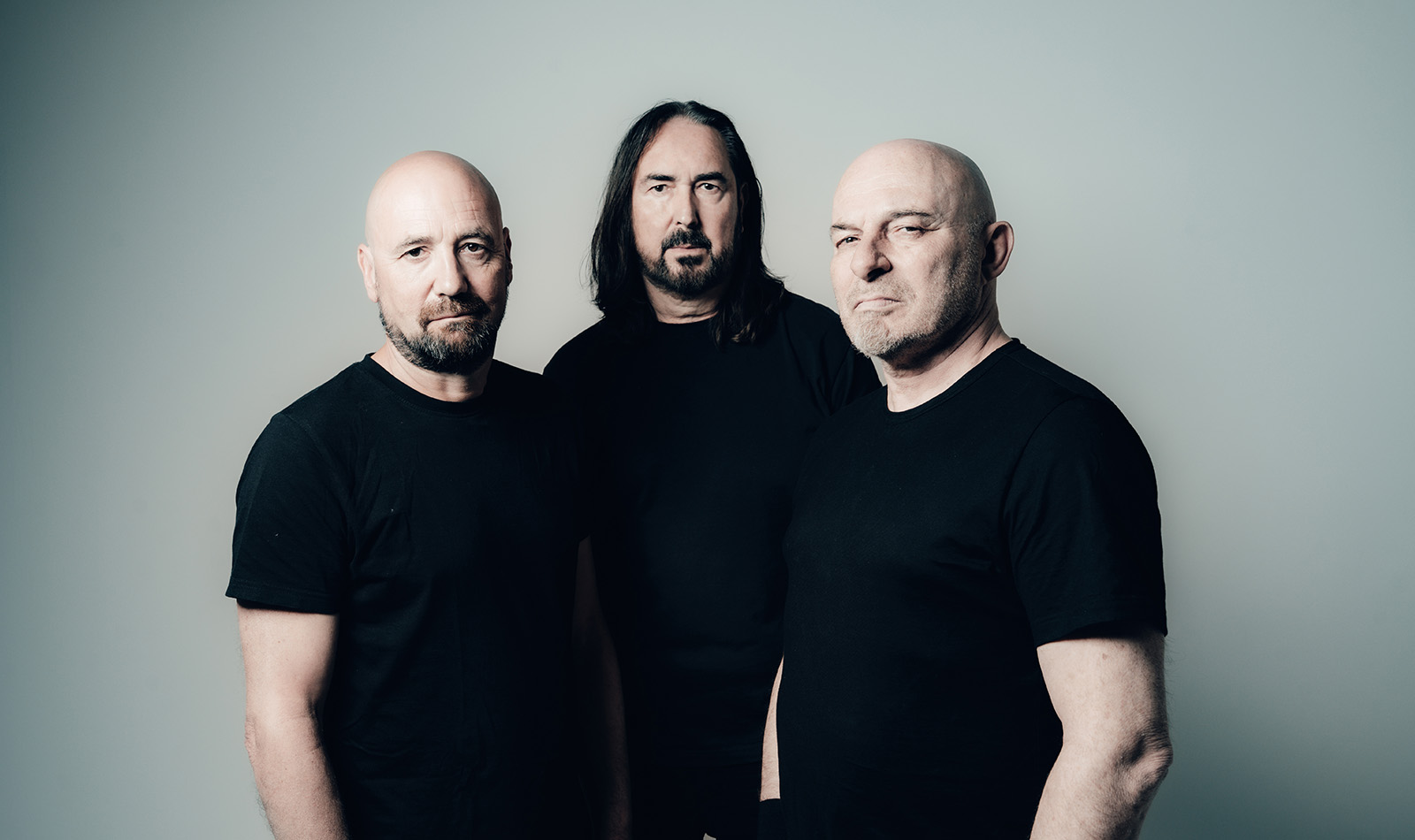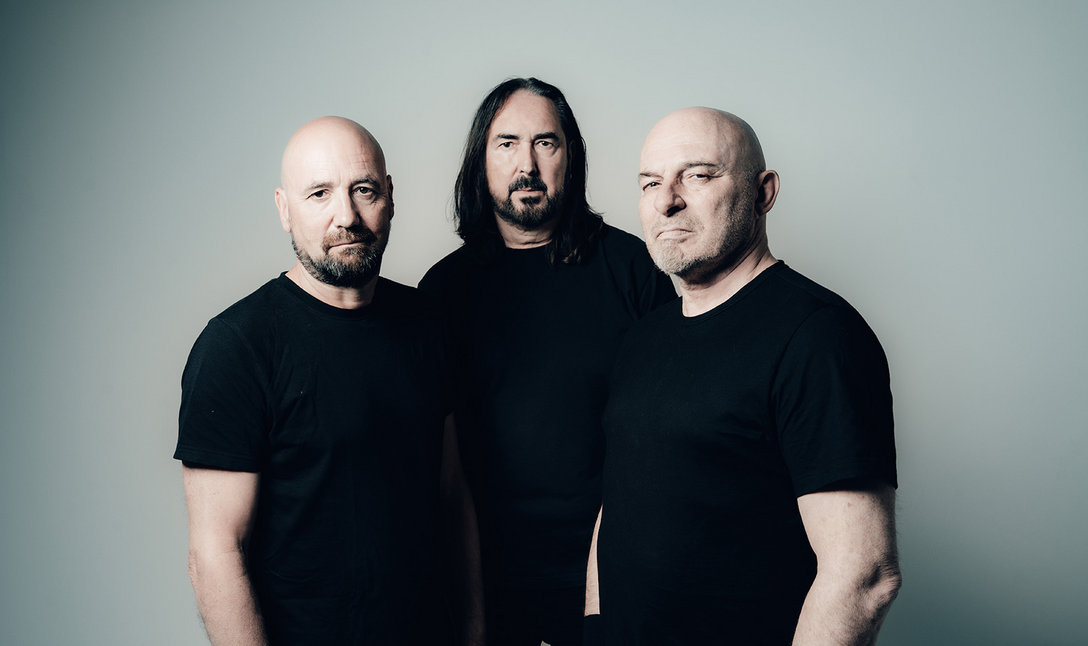Great Thrash Never Dies: The Return of Coroner
By
·
October 15, 2025

It’s been more than three decades since Coroner last released a new album, but listening to their long-awaited return Dissonance Theory, it doesn’t sound like they took off more than a few weeks. All the hallmarks of the Swiss band’s innovative approach to thrash metal remain intact. Tommy Vetterli’s serrated guitar riffs still slash through the center of the songs, cutting a path between fiendish technical precision and toe-tapping memorability. Ron Broder’s bass lines offer probing, pulsing contrapuntal grooves, and his perpetually snarling vocals sound as menacing as ever. The drums, now played by Diego Rapacchietti instead of founding member Marky Edelmann, are as forceful as they are nimble, with Rapacchietti gracefully darting around the kit even as he punishes it. This being a Coroner album, Dissonance Theory also represents a step forward for the band. Each entry in their discography has pushed their distinctive sound into new territory, and that exploratory spirit is what powers Dissonance Theory. It’s an album that could only have been made by Coroner, and only now.
“Before I started [writing], I thought a lot about how the band should sound nowadays,” Vetterli says. “But I found out pretty fast that that doesn’t make any sense. I can’t write [Coroner’s 1987 debut] R.I.P. again, because I’m a totally different person now. I’m almost 60. I was 20-something back then. That’s just not possible. So I decided to just sit down and see what comes out.”
Dissonance Theory may not be R.I.P., but it exists in continuity with it. Coroner’s beginnings are the stuff of legend, even if the story that’s often told is somewhat apocryphal. In 1986, the band asked Celtic Frost frontman and fellow Zürich native Tom G. Warrior to sing on their Death Cult demo. A few months later, Warrior asked Vetterli and Edelmann if they’d want to come roadie for Celtic Frost’s upcoming U.S. tour. That was a crucial experience for the young musicians—but it’s not, as some would have it, the reason they got Coroner off the ground.
“People think we were the roadies, and then we had the idea, ‘Oh, we could form a band as well!’ But it wasn’t like that,” Vetterli explains. “It was a chance to see how a tour works, and every time Tom did an interview, we gave the interviewer a tape. The demo was already out, and that was very good for us. It was a good start. But after this tour, I think I did one more show [as Celtic Frost’s roadie] somewhere in Germany or Belgium, and that was it.”
Like Celtic Frost, whose blend of primordial black metal, death metal, doom, and thrash remains totally singular, Coroner never adhered rigidly to a particular subgenre. Edelmann was into hardcore punk bands like Discharge and early extreme metal acts like Venom; Vetterli and Broder had played in a Dokken-ish hard rock band in Zürich but longed to play something heavier and more technical, like Iron Maiden. The trio found their common ground in Denmark, where a corpse paint–clad frontman was leading a top-notch band through thickets of guitar harmonies and complex structures.
“We could all could agree on Mercyful Fate,” Vetterli says. “Mercyful Fate was the most important band in the beginning, because they were melodic, but technical, and a little proggy.”
Coroner didn’t quite arrive fully formed on R.I.P. (“We wanted to show that we practiced a lot, I guess,” Vetterli laughs.) But the path was laid. Across their next four albums—1988’s Punishment for Decadence, 1989’s No More Color, 1991’s Mental Vortex, and 1993’s Grin—the band would warp and redefine the contours of thrash, bringing their self-evident technical proficiency into equilibrium with catchy melodies, off-kilter rhythms, unusual sonic textures, and quirky songwriting choices. Their idiosyncrasy reached its apotheosis on Grin, an album that teetered on a brink between technical thrash and gleaming, ultra-modern, industrial-tinged groove metal. For the first time, it felt like Coroner had bumped up against its ceiling.
“It was a strange time,” Vetterli recalls. “Metal was declining. In Zürich, there was this techno music thing going on. It was interesting for us, actually, because we were open-minded, musically. We’ve always tried to do something a bit newer and do stuff we liked. We hung out a lot at techno parties. We took some mind-altering substances sometimes, and that was a lot of fun. And then, maybe, I think it was just time to do something else.”
The band didn’t enter the sessions for Grin expecting to take a hiatus, but they made a mutual decision to part ways upon the conclusion of its touring cycle. Edelmann teamed up with Tom G. Warrior for his industrial metal project Apollyon Sun, while Vetterli joined German thrash greats Kreator for their Outcast and Endorama albums and started his New Sound Studio just outside of Zürich. Broder stepped away from music altogether. It wasn’t until 2011, nearly 20 years after the release of Grin, that Coroner started to play together again. Vetterli wryly notes that the reunion finally happened, at least in part, because the festival offers got big enough that they couldn’t say no. But it’s also true that the impact of Coroner on subsequent generations of metal bands had become unignorable.
“On YouTube, we saw young musicians playing our stuff, and it was like, “People still like what we did 20 years ago? That’s weird,’” Vetterli remembers. “Even people like Mikael Åkerfeldt from Opeth, he came to me and was like, ‘Back in the day, when I didn’t know how to go on with a song, I asked my band, ‘What would Tommy do?’ I almost fell, you know? I mean, Åkerfeldt is a genius. I love Opeth to death. It was like, ‘Okay!’ We never made a lot of money, but this feels very good.”
A couple of years into Coroner’s reunion era, Vetterli started getting the itch to write music again. (Around the same time, Rapacchietti took over drum duties from Edelmann, who left Coroner to focus on his doom band, Tar Pond.) By then, recording bands at New Sound was taking up almost all of Vetterli’s time, and he found it impossible to compose music in the same space where he did his production work. The process was at times painfully slow, but over the course of the next decade, the album that would become Dissonance Theory came together.
“I had to go to the mountains, just myself, and get in the mood, and then it worked,” Vetterli says. “But to find this time, that was a bit difficult, and there’s a lot of other stuff that happened. People died, and I went through a divorce, and then fucking Covid happened, and maybe I had a little bit of a procrastination problem as well. Maybe I was a little bit afraid, because the expectations on ourselves were really high.”
Dissonance Theory manages to clear that self-imposed bar through sheer meticulousness. Vetterli says that out of every “50 riffs, maybe one made it on the album.” The opening riff from “Renewal”—the first advance single from the album, and thus the first new Coroner song anyone had heard in 32 years—was written by Vetterli in Thailand in 2015 and tweaked and rearranged for almost a decade. Rapacchietti’s drum parts were recorded, in totality, twice—once before Broder laid down his bass lines, and again after it was clear the bass was changing the shape of the songs. Vetterli brought in his American friend Dennis Russ to co-produce and help out with the lyrics, which tackle religion, artificial intelligence, and the atomic bomb with cynical precision (and, strikingly, perfect English.)
Vetterli is also in career-best shape as a guitarist. Songs like “The Law” and “Trinity” start out eerie and contemplative before erupting into climaxes colored with daring flourishes of melody. “Consequence” and “Renewal” test Vetterli’s pick-hand dexterity, and nearly every song has a solo that deserves to be transcribed in Guitar World so aspiring shredders can torture themselves. Dissonance Theory’s technical extremity might not jump out of the speakers on first listen in the manner of Coroner’s early albums, but don’t mistake that for Vetterli losing a step as a player. He just doesn’t have anything to prove anymore.
“I think the main difference is that maybe in the past, I played more technical for the sake of being technical, and nowadays, the mood and vibe and the expression are way more important for me,” Vetterli says. “If there is a fast part, I do it because I think that’s needed there, not as a show-off.”
The deluxe edition of Dissonance Theory will come packaged with a new remaster of the Death Cult demo, the Tom G. Warrior-fronted artifact that set Coroner on this path 40 years ago. Listening to the oldest and newest Coroner songs in quick succession is a bit of a head trip. Understandably, there’s a quantum leap between the brash, atavistic songs on Death Cult and the sculpted mastery of Dissonance Theory. Yet hearing them side by side also brings out their shared sense of purpose, the confrontational oddness and boundary-pushing ambition that this band had in spades from the very beginning.
“I was a car mechanic at the time, and we took a week off to go to the studio to make this,” Vetterli says of Death Cult. “This changed my world. After this week, I had to speak to my parents to say, ‘I want to be a musician, I want to stop repairing cars, I’m not interested in that.’ The rest is history.”

